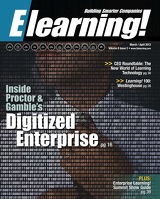Elearning! Magazine: Building Smarter Companies via Learning & Workplace Technologies.


Page 13 of 52
Businessof Learning Selecting an LMS: Vendor Selection Methodology
COMPARING WHAT YOU NEED WITH WHAT'S AVAILABLE IN THE MARKETPLACE IS THE KEY TO FINDING THE RIGHT PRODUCT.
BY JOE DIDONATO I
n the August issue of Elearning! Magazine, I discussed the enterprise "needs analysis" phase that leads up to the creation of an RFP (Request for Proposal). In that phase, we went through a process that identified our needed functionality, which could range from e-commerce to global calendars and languages. In turn, these functional requirements became our statement of busi- ness needs in the RFP.
1) weighted "best-fit" comparisons; and 2) proof-of-concepts or "bake-offs" Although each of these topics could consume multiple chapters, this article will highlight the gener- al approach for each of these methods.
In this segment, we'll be looking at two approaches to compare vendor solutions:
'BEST FIT' METHODOLOGY This is my recommended approach. It weighs all of an enterprise's needs together, and yields a "best- fit" selection. To help you understand this approach, I'll use a non-LMS example. Assume that you have to choose between three jobs. As you think through these opportunities, you find yourself vacillating between each job. By using this "best-fit" methodology, you can create a mathe-
matical model to choose the job that's right for you. First, you need to construct a list of criteria or requirements that are important to you. In this example, your criteria might have to do with career opportunities, salary, location, and other criteria. Next, popu- late the spreadsheet as shown below, with the criteria in the first col- umn. In the next column weight each of your criteria on a scale of 1 to 10. Third, rate how each job satisfies your "need criteria" on a scale of 1 to 10. Lastly, multiply those numbers to get a value for each criterion for each job. For example, Job #3 yields the highest "total value" for "salary," and Job #2
is the lowest. When you then add up all of the "total values" for each job, you create a "best fit score" that points you to the best selection. In this case, Job #1 is the "best fit" for you:
Best-Fit Methodology Your Criteria
Career Opportunity Salary
Best-Fit Score 8
Location 54 20 Work-at-Home People
10 10
10
10 10
Assigned Your Weight Rating
10 6
Job #1 Job #1 Job #2 Job #2 Job #3 Job #3 Total
Your
Value Rating 80
60
100 100 360
5 5
10 10 10
Total
50 50
100 100 340
Your
8 8 8 5
Total
Value Rating Value 40
64 80 40 50
10
100 276
Elearning! March / April 2012 13


